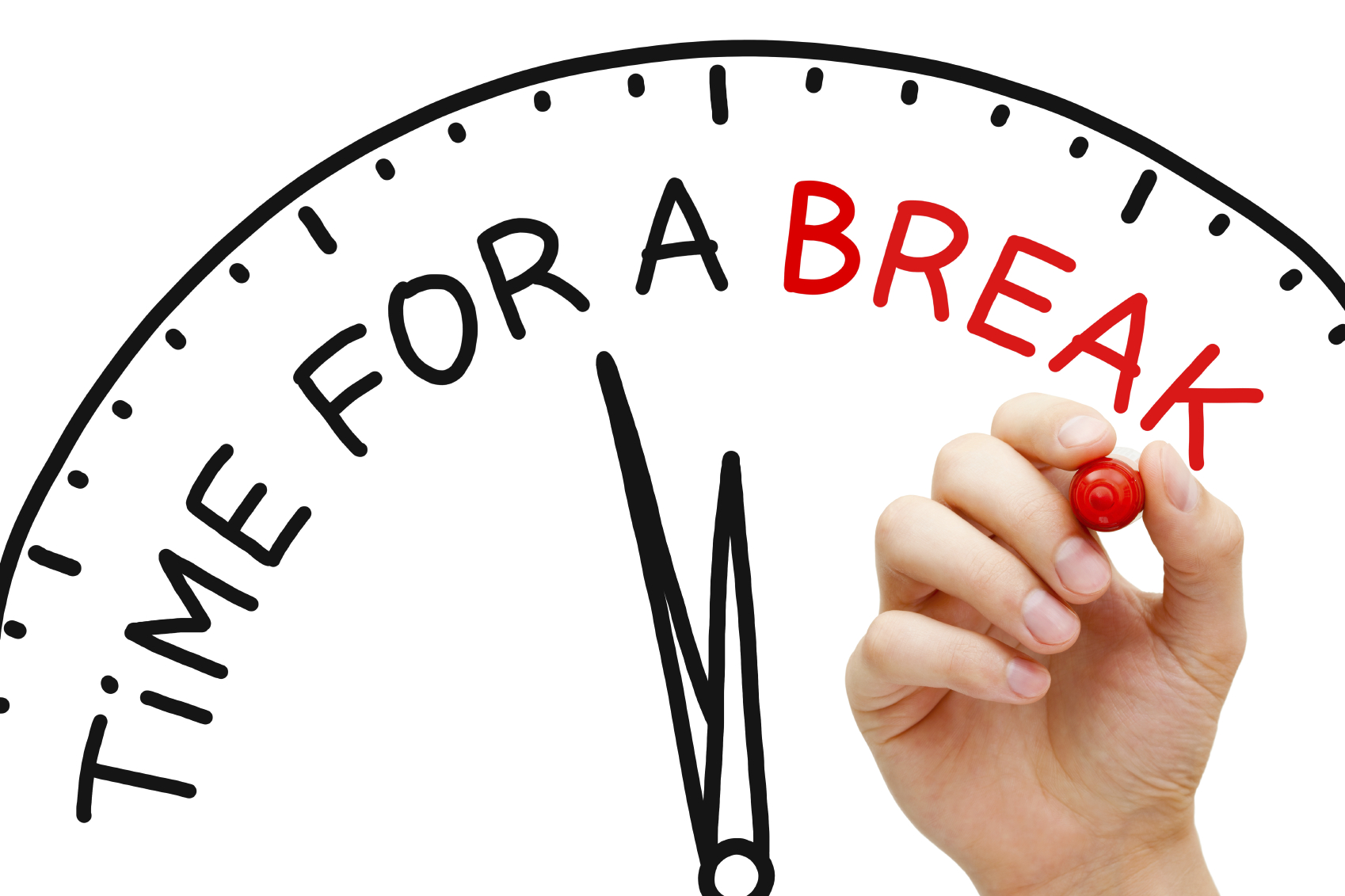Give Me a Better Break: Choosing Workday Break Activities to Maximize Resource Recovery
Emily M. Hunter, PhD and Cindy Wu, PhD
 The average worker would agree that breaks, although not necessary, are helpful in making a workday more manageable and possibly enjoyable. Research has shown the benefits of evenings, weekends, and vacations on employee health and performance, but surprisingly little research has investigated breaks during the actual workday itself. In this study, our goal was to understand how breaks can benefit employees and organizations through improved health and well-being and to provide advice for breaks during the workday by determining when, where, and how break activities are most beneficial. Defining a break as a stretch of time in the day when employees turn their attention away from work, we examined the impacts of breaks on physical as well as emotional health, job satisfaction, and the extent to which employees go above and beyond contractual obligations.
The average worker would agree that breaks, although not necessary, are helpful in making a workday more manageable and possibly enjoyable. Research has shown the benefits of evenings, weekends, and vacations on employee health and performance, but surprisingly little research has investigated breaks during the actual workday itself. In this study, our goal was to understand how breaks can benefit employees and organizations through improved health and well-being and to provide advice for breaks during the workday by determining when, where, and how break activities are most beneficial. Defining a break as a stretch of time in the day when employees turn their attention away from work, we examined the impacts of breaks on physical as well as emotional health, job satisfaction, and the extent to which employees go above and beyond contractual obligations.
Characteristics of Workday Break Activities That Enhance Resource Recovery: Research and Results
In order to accomplish this study, we tapped workers from a mid-sized, private university in the southern United States. The average age of participants was 46 years old with average length of 7 years on the job. Additionally, a majority of the participants spent a good portion of their day behind computers, which can have an effect on eyestrain, headaches, lower back pain, and muscular effects. Participants were instructed to complete a short online survey after every break they took for a week as well as complete a final survey at the end of the week that measured job satisfaction, emotional health and the extent to which they go above and beyond contractual obligations. The study controlled for quality of sleep the night before as well as perceived resources (i.e., energy, concentration and motivation) immediately before the break.
Drawing on previous studies that showed relaxing breaks related to less fatigue, we studied multiple aspects of the workday break to determine efficacy in increasing recovery. Analyzing different aspects of a workday break, we found that the characteristics of a break that replenish resources (i.e., energy, concentration and motivation) most are doing a break activity that is enjoyed by the employee and taken earlier in the day. Additionally, we found that breaks across the work week decreased burnout, increased job satisfaction, and increased the extent to which an employee goes above and beyond contractual obligations.
Our first prescriptive finding is that breaks are more effective when spent on a preferred activity. When employees engage in an activity that they prefer, resources are recovered more effectively because the employees choose the activities that they desire to do and thus such engagement does not require additional mental energy. Also, preferred activities on break are more enjoyable and relaxing, allowing precious resources like energy and concentration to replenish.
Our second finding determined the time of day enabling the highest recovery of resources. For employees who spend most of their day working on computers, previous research has shown that resources decline as the day progresses. As resources are expended throughout the day, an employee will experience increasing difficulty meeting demands of work if there is not sufficient time for rest. We found that breaks taken earlier in the day recovered more resources than breaks taken later in the day. Therefore, in order to maximize output for an entire day, an employee should front-load their day with breaks to keep resources higher as the day progresses. Additionally, due to decreased effectiveness of afternoon breaks, it is critical to engage in preferred activities to maximize resource recovery.
Interestingly, we found that break activities requiring higher efforts (e.g., exercising or going for a walk) did not significantly recover resources after the break. Previous research revealed the opposite effect, suggesting that being actively engaged with an activity helps the mind turn from work to relaxation thus decreasing the need for recovery. However, our research suggests that exercising can have a positive resource-replenishing effect only if exercising is a preferred activity. In such cases, resources are replenished more effectively following exercise for such workers than if such employees participate in a non-preferred work break activity.
Implications for Real Estate Sales Professionals
 Although this study was done in the context of a university setting, we believe the resource recovery process for university workers and real estate professionals is quite similar. In both types of roles, the employees interact with people (students vs. clients) and spend a fair amount of time on computers. University workers and real estate professionals have jobs that “never completely finish” at the end of the day. Therefore, the need to take breaks is amplified in these types of roles.
Although this study was done in the context of a university setting, we believe the resource recovery process for university workers and real estate professionals is quite similar. In both types of roles, the employees interact with people (students vs. clients) and spend a fair amount of time on computers. University workers and real estate professionals have jobs that “never completely finish” at the end of the day. Therefore, the need to take breaks is amplified in these types of roles.
- Schedule breaks in your day. Since a real estate professional’s day can look very different from day to day, it is easy to tell yourself that you will take a break when the opportunity arises. However, a real estate agent’s day can fill up very quickly and before you realize it, the workday is winding down and you have not stopped. For those long days with clients, schedule an actual break in the day to allow your clients space to talk about the homes and give you a true break to refresh your resources. Scheduling breaks in the midst of your day will help you recover spent resources – giving you the energy, motivation and concentration that your client needs when working with you.
- Make your break activities something you enjoy. Oftentimes we have heard that the best activity to do during a break is exercising. Although exercise is important to a person’s health, exercising is not always the best method to recover resources spent throughout the day. Resources are best recovered when participating in an activity that you most prefer. If you prefer being outside, go for a short walk after you leave your client. If you prefer reading the news, open your favorite news app to read in the car while waiting for your clients. If you do not know the activities that refresh you, experiment with a new activity once a week and take note of how you felt afterwards and what activity refreshed you most.
- For longer days spent behind the computer, schedule breaks earlier in the day. Real estate professionals need to spend time on the computer. However, those days behind the computer can be some of the more tiring days since computer work can be quite repetitive. In order to maximize resource recovery, schedule breaks earlier in the day to front-load recovery in order to keep resources high throughout the day. So take that mid-morning coffee-break; don’t wait until lunch to get away.
- Take more short breaks throughout the day, rather than fewer long breaks. When an employee takes more breaks throughout the day, his/her resources after the breaks were found to be higher after more frequent, but shorter breaks. Therefore, in order to increase resource recovery, an employee should schedule more frequent, shorter breaks throughout the day. Although this may seem impractical, scheduling a five-minute break on the hour will help keep your resources high versus trying to recoup all spent resources after three hours of no breaks. During this time, take a quick walk around the office or close your eyes for two minutes while listening to some soothing music. These shorter but more frequent breaks will help keep resources at a maximum throughout the day.
Conclusion
In order to perform their best for their clients, real estate professionals must keep their vitality and excitement for their job at a maximum. In order to do that, breaks during the workday play a vital role. Although it is a challenge to have the discipline to take breaks throughout the day, real estate professionals can dramatically increase their energy, motivation and concentration by pausing their workday to allow their body and mind to recover.
. . . . . . . . . . . . . . . . . . .
Recommended Reading
Hunter, Emily M. & Cindy Wu (2015), “Give Me a Better Break: Choosing Workday Break Activities to Maximize Resource Recovery,” Journal of Applied Psychology, 101(2), 302-311.
. . . . . . . . . . . . . . . . . . .
About the Authors
Emily Hunter, PhD
Associate Professor of Management, Baylor University
Emily M. Hunter is an Associate Professor of Management in the Hankamer School of Business at Baylor University. She earned her Ph.D. in Industrial-Organizational Psychology at the University of Houston in 2009. Emily teaches negotiation and conflict resolution to undergraduates and organizational behavior to MBA students. She also conducts research on work-family conflict, employee deviance and servant leadership which has been published in the Journal of Management and the Journal of Applied Psychology among others.
Cindy Wu, PhD
Associate Professor of Management, Baylor University
Cindy Wu is an Associate Professor of Management in the Hankamer School of Business at Baylor University. She received her Ph.D. in Human Resources and Industrial Relations at the University of Illinois at Urbana-Champaign. Cindy teaches human resource management to undergraduate students from a variety of majors. Her current research focuses on leadership and employee wellness, and her work has been published in well-respected journals including the Journal of Applied Psychology, Journal of International Business Studies, and Human Resource Management.